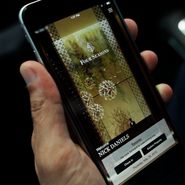Tablet use in all stages of travel has increased among travelers in the United Kingdom, according to a report from Expedia.
Smartphone and tablet ownership rates in the UK, at 79 percent and 43 percent respectively, are higher than those of the United States and continental Europe. While it is widely known that mobile and multi-platform use is growing, understanding these trends on a regional level could help brands fine-tune their marketing mix at a regional level.
Time of the tablet
Mobile-only travelers outnumber PC-only travelers, and the total mobile audience matches the total PC audience, demonstrating how quickly mobile has grown. In the UK, mobile rather than desktop is the primary tool for travelers.
However, the significant exception is with hotel and resort research, where 53 percent of travelers are PC-only, compared to 29 percent being mobile-only. Additionally, these users spend nearly 3.5 times as much time on the site as mobile users, although such users are slightly less likely to be luxury travelers.

Image courtesy Bloomingdale's
As one would expect, PC use is considerably lower during trips, but the platform dominates during research, shopping and trip-planning phases, all of which have lower mobile rates. Tablet use, however, is used consistently throughout the journey, a big improvement from its limited use across all travel stages in 2014.
Tablet usage is particularly pronounced among luxury consumers, who have the highest rates of tablet usage by around 10 percent during each stage. Purchases are following suit, with 36 percent of travel being booked on a tablet compared to just 16 percent on smartphones, whereas the rates are more balanced in the United States.
Just as importantly, tablet-using travelers are nearly twice as likely as smartphone users to click intentionally on ads, 21 percent to 13 percent. Advertisers should also take note of the kind of ads they make for smartphones versus tablets, as the top reason for clicking for smartphone users was the relevance, whereas tablet users were drawn by attention-grabbing ads.
The full report includes further statistics about rates of different platforms in the UK as compared to the U.S. and in the previous year.
Falling behind
While the growth of mobile among consumers has been duly noted, marketers should take note of the peculiarities of different markets. Superior digital marketing by third-parties have led to a reduction in margins for hotels.
Affiliate sites and online travel agencies have kicked brands out of first-page search results, according to a new report by L2.
Across 452 non-branded keywords, TripAdvisor had the highest first-page display rate by a significant portion, and similar sites and online travel agencies (OTAs) dominated the top 10. To make themselves visible to prospective travelers researching online, brands must make themselves visible on these sites and target consumers by region. (see story).
The travel sector is lagging behind in dragging mobile conversions.
While 32 percent of overall online payments were made on a mobile device in the first quarter of 2016, in the travel sector, the share drops to 15 percent, pointing to an opportunity to extend the reach of smartphones in the travel experience, according to a new report from Adyen.
The report, Mobile Payments Index 2016: Travel Edition, reveals that accommodation services see 17 percent of volume on mobile devices while airlines see just 13 percent. Tablets remain a significant factor in driving booking in the travel industry (see story).
{"ct":"w1phVCD\/Rq4s6PI4k2mnOg8aVLQ2zrNxPQmbSmcqj3y3RhxGLWaRlh8Yo1zRSCP9rfDcDKxXu4VPzvs9Xp78soXTWoBj4pyyk9FACA3q4+HWxRtx0W7DAMwYpW48WQO9QpAt\/BCFYnOldMVQKlGjp4rFZTwiZN4c6rv7\/\/o0ST8wZ0kR5X\/KH8dqOs1Df\/eN8ypWnrAtpvPOzduOZ4kY61VxIAKySDauqz7J\/dLBln1OgYIzT\/3\/yWgScVIng1KOm+Mj\/G5cDbTRdjePhB+l7Pevkw9mnZtOzVzFSo9PdNfga1pGio2BMn0XSAHgC3D85iR3NI6uG0DKbye6b1embXleSSGxv93WcLNSUNOK\/nMHsEC0g17bDphqrQhnOJ21g1w0ft813Dzb7YN6zDLjBBf+IV+3aEtZw6U4se1tMwxyjqx8ZZZ+HcGIac0eUH8416dIvrMwgRbNad3oei5InXg1Fcw4vAj\/DAKTI\/ZaLn1Q+2cbzaWzwFg2yeWKjqPNd9JYcKpMatVfKVyQfR\/shr\/3iB1\/8RBGSj5ycPoUZEVm8nrotGki78b\/v8JpKDidHTr+Q1VnKUg0Ub3sYYUexqs50XevAq1fe\/AZBu+mOYuVjhD1Ybiu3q5FGpv+8RHNggBPiPftqkgTeufRjGTfKFthd0oAGgCtSGe6sHLSiLqxDr38LATe8I\/SXVB2vCU8BPN\/5d1s03JHLf5NUOzuOzHyjvYqi\/\/BdsavOUiRYQSseiY1c5s9i1Jqnfm3gfkxH8IKCTYGnoZ56bYTO4K0bYh8yhwQYK2ZlOlLxkxVLqN0\/xpMuDqBet6iO1L59G+\/Rv76GNvbvMA7oJDOdvjnh7NRc7MzuEPaSf\/tj9RyUtXpR4y0R+qBRyKW\/Ec\/+qBmdwd9+ou\/+1RGYLoYtTIBbpZhM82mSGIUTqY\/6HY4N333769uOmRaK5EdGGxfmAKZdwUOoo28gESY9hpBUgW2EczoN9YEYw2nCokn\/eFSk5b3eo54DP2TjakX5EEC+TmRDj4QA715bydzkF+oPMCgY0DQcjlznEt4n5+q7M7t2MXDBKaOeOsPNmmVPO4qOXCrYwydX7Q9wMPcJwCnZJm1pG8zS1Hj8LaEVUJ\/OkfmplvTv67okQ382DKUBkkwMl38DSOrUz+r02Q1WHxUZYlNOBbL6oNj5APf22IkCZIB7IkRbMBwdi0hbf7GUY1cf32vSwScV2Mc2ZeslkV9hP3usDq8Ej6hxnlTpKWd6C64+MWd6MhrY753SFrzK0RiUuBPXeQf6r2qk8h4BmUVGdtYHo2S9gdujs9nrsm23gLMSmVfvIBxQ6HbGBPxNkfUsmcGv+6aKdMvqtZBf9IOoTs3E3qnU0mutdjQZia+Uv8Y9DoSySpHUkpGDijNCifwv6xyuVABPGWpbCXwVM5euE1b7DGcJunWqV75SwHlfb9TBhUBmAOtpIJMRFgwS0ZgMMoV0ud2Q8dduFrqBZhPGx2WgvqeC1rGKAEaaBF+WoCdKXcGNQQAASB3TQ2QQuxMiEyTZDfAFExKXWWPZ9sVpFiqNo1AweY59UAb\/d2lcmzAM+iPTXpdCBquWYQ7CUsoHK2ltu+TM3AdPQn599ioBaZzCB9gqKLwvt0z9mXSNC82XRXfRWjjSZxW3W8RFXTRGHbdgGdYSWkvmQE5sB+pXAZ2HUV9eo80d0CXEGRIDgT1RXxqT\/EmA\/gWF2XL1HRU2XuUPq\/atM36EULfVZR8XPNELACQ+SzWJPaKgrEeb5q6XZUXq0cr07V0EW3NGi1aoKrPe+MPtMoEwCP0WmXG8UVE3QhqONFDUeU3Kd2zOAPZzFdboIM5vlIAWCQ913ckBxuCv0a16ylX5Sw0PirgqxbQ9xu\/9dbS3xnMP0oVs88ueqAgEjO2Xd7RQ72ORdMHrlPUW6ZqKR6xD1l16vtOpTQJChoE22OnpxJsRzuZX+qxdU6IBKgSlCpmE2T4La0Soly6Wa\/Rt1pqQCpkquxEPSb0SeMQSlfGOqoTMdp5CKp5kunLV2v+KTYg9Hx9XFv\/16y5sNzqY5a7MWX1akAoHHZTvWToQIe0n2d92ntXDVFdNUA8bu2tV2eMyDT\/tXVgll7+siKnEFysK07RQd4cExsM8uJKuzwYnW9oWe6nG0sCc7tIL8fdBhzUzsvj1auNOf1vw83H4iPF4eFQxh30x9KAyYnIXQxcjRFmhpNOtEI82VrOm4bRMGJKBiVjrPyW+17Gsv\/X6T+qpg2RqEQUQGkOM4NCc2WZwxRXpAWk9BpLdo0v\/twT9bDNk\/6+7sRsNLDlCGr+iKUYyGtYVKbAx6odqs\/E8FXMvYJP\/wX+NfDApLDvrVHXTIPA+b+BkYSUHNtTBChnru5MkQJO0AW0Kh7rfZJ6r2kc1X6SzEUMoZj57NAzOoxkWQF2uCHZn+jRFfPuANIG\/VnB+Ho\/6hvRHM11eH0BMHiphGqJjNySwQl5nxI3lCvKIkPTjau2d4Zer101H0o7Azt0udQKZD2FRCC4vxHwKgUdoQ1iG+TQstNGIIHduIpJtdmnyEUgRfBLsPr+IanJjTUHWb+W+wwzv5lD70X+KIMk3\/xKQR9uvOFhaia3mC34qO+OM4TcWiRu0RJo5VOgzz13qJ1cgbpVduf4vYgV520cnZbcm2nE0erCeP0vY3N9fCQrq0cOO98ajJ8GQ76hpQLtQFf52PW9WCum0PmAU8Pnp8x\/Y1j4h++QKHJjLgPPcrBxOXtBV7B93GrDLhAyJoiB0rkuaBLlUPvNdCTZi91xhionr7jxRX9OPDHV6T5UpU+WVoMEURlWFdxpLZ88+p1R5MIDA6hgSwbTBAAMSxMoAqoSGJJFEcEVm4q6IEO2iDHsDoz2D96ajRV3S+Zux9\/y8Jl4OGKMMiShWpNSnvj3LWeZZvaIbT3GRZfdUuDzaQEvoNhpUjZ6T2CN7pPo1+oAoK3J0PVwQEsVciCwtTsY4KfAefOcSZ0C1\/oQ7NNi0b07q9hdQNTmZYy4anZYSB8low5zKUFtss9BkQ1hlA5mwJbdscJghKGxV4RVLgR8ddIesKncXGIELXc3bjwmvo9zcDcs6N0X8m2aOp4YgamfSyx6h3RBsRK8OWeg7NBiW0G87nx9QazhMKgQSI1\/Gyb7Qi2j6TM+601Nv9VNfcY0DE+zWjeuKJ+HUux4a+r6r3Il8rgeE4j90b1yLyEEUy\/VKwxCJEDkggru1sHpZeWGvrURh3MOw3CTi3hPmv8H0TnCccAsrqfTF4pykmdYoOxs7T5L8lUMU\/glt21mjZMTUIFI+bBZAN8gyo8E3pRqb9cf\/fuXTX80Iwy9Rm\/Vt1fV\/0qMaY0bcfo5QgYOr43YZsbDmd0Z3cuyB6FjJLAKOVVlqloOzwLORYeuLyGqXsmMkw3X7GPJ2tULFZT+X1sJ1SphZvLDCgD9X5GoZKwozB+CCK8Fe7ybIioF3FIVjZPHMyqYEuPg6pBqPKRP\/N00cLWLYucq\/sfffLAY5S4vZsx25OmUqTomCbUDMkEJHPe0sN9uNvCFQN58brnqGAeOcKx9EBQIAnblXkqA2hsSTchUv9vJ7pQ1l4MJ5+ffINXTJIaGOU7jvXoaCM1+TZU6jMllpTjDtz25SEgmMFcq5+HbdxPbbCix+Blwz4QRLlA01v7j5Fh3JDXR3VPgx0ArsAIAF66fqwOIyU7N1xjo\/+JkGIPknD+56Id3xOeEO34MX3Puqfc+nD55etio4s\/3tpcuCpIMfvvhyPvx6zOzMmnMNiJBHUEuDTyYKUVwL\/zVrHbrHZS3mCSWuG\/gcEkEjQQZa+AzI9cPAVuWX19w1ApuFee+BhzHhUfY\/AYSDKybyEzl7z0OPNsSjx1cacErjLgz9kQEXHEPtVCDjKRQQsqNZ2NiH+Jv2OEYTaG4sJUHlfPkMgAw4mtMAbTLDVyUC1yp2pqVoqFX8wcoRvmwMNxgaKb6N3bSS2OKa8CV\/abczRKk116UX7Li6uU6ApXvVEbG7OAsZ69I+IWjVhOVL\/S7WqfhGJO1X3cVT84qMEqLrcJ\/Fn39edowhUGCoHiD1tuFwbm9eB0S89s0U8WjZdQMJ+etIVLT3sbVeq5jF5FfNA1Y2SwFsEZuE1vFajtZk\/FZrrqeQYmg4uhfzZk6xG+k8nY05FEp7fB6cGbx\/xokDO\/Vtl0wkNeGkYQfZSKHG6JA22nJ4foGcMakUce1mpDuVxW\/hvdF13oyCURyMgNxh2dM5Dyh5tssVm+gJOZG\/vhQmWIIeyKfKHqG8YEpZ25zCNwYaR0tQHvSzObots+huhW7uPN8floMO\/Dm0\/Ftpgti5HZm6MoGkgePnTzPgCV6vhgqD2qYQUYAkD+nYijRPndKUuX9izNGHIZp52YUS9vi8KE6Wv030swEsmcdhxV6H+gVKIdbNOIVF8nxDU\/ND6xkheS9CEnWUhZK\/YP1+3DZQUlpB9TNmU7sQGEXkrQIboydBeZVzuxgzh9xau\/yCDgnrwgKQi7h6e0hxRhZhRGm0Tph0sYzOS0pAyUsITnvJRvHU\/K9nTt8DOZL500laRXS9Jb3z\/ApTVbIy08pTKp2HhQ1afSA29BtHvGEATkN9o0wpkXo\/gTP96uhw4Vm3O15nVQXRbd3MRBxzsIPV3o6YuTpJk1IFPIYhN1oSB5ax4q3hraFn6x40UCP3fm65iVlX409icrFxFlP2S83eXxrnn32iVqYyWk6DL9WRA9Nrnx1JfLR9bnJ+0R+erspUxH4XeCcwOHub4fHoGJj1ujlvUKEERSpDIN74UE4pVNWwK8vFataiDLutuGi65tUa7D4L84r4Gc+HDhwhc80dzlCJ+MgQkCT\/tYzmsPW+iCIInMO2ETZsJXoHRZ2+eV4RhazIuxSJx8n0Eg\/GIWVX9AMrP161N1TPVhf3kY6xyKk83GQdkFBFlYfNCO\/E6otfZvPT\/FfRWlzh6yTeOT8PTzajmzFLv4UrqM6DLxnBf3f6AGS34vtyPBdeO4q9UPVtgZ5ztwxQnBM4VJbMguvBokPNeyyHh45lRfjedyoFJ++vBeXmyq6hFYHq4jVz9ixAgkVTO7ZScK8p0yFq6T3FzvGrNSGM\/+HH9ib9p8FbtlzkVD3TEVD8fX3JGaxB48V9J9I7TTzQHf1g9rmmx4Y5QPpPM1eASQSHEFHdwXYcLE8yEFkPUdIiLYslHIotCX9O9gCpxi\/Fpg\/Wyhs7AyNiDWq3Epg3i9KR69V\/2R\/FkcBV4UI\/aYZC8O0EnGPrMitOQsCdoF5I1WVSxa+TeQ5fLja6u9I8vbI4Lw1\/21flevQkfmdgZ6TiJ\/j2mkXs97UVmGp2Oh2wlta7BHU6sRWWQls2CbyxRUwv6ekI1e2CKpTk\/8acaWIdLf3R+Koq0OewN0u2KQCaGyQqwPeS6zwM6MM8uEMXtH65GpGtXSJhEls27MnI7ENrt\/p9clw2R\/Uc7Yhxk+3s8rUkA8OWt81XhuD2vcujDOf91mP42FnNXlJDvA1hByMdvYMJu96eCQip0WYpqaDo1krgifUhNM75mnsEBmsKbepJjtrAlbLryIVoPufeCVha+lPxuVTrbiOUZfx+wLFiwqDMd\/EmxoT3q8\/fmlBbRVCbLaL4gSmBIZaVwh86xsCNcF81sCntJYhMkWPbFu7wvtq\/f9Re59VT3ozVoyoilbJhhbeT1K1tVT804VcpLWayobGS48WDqI5pkwLLeI\/xMF\/rX53WXULsBtnWq1GitvN9iA55qeoUdjJw2p9X3ltc6VIwditQ9QRsxO2jKE7BxWzEYCIHUvjz6faTAdp\/MFYT623yR0ifFflF7kq\/A1nuar5T82m5TLBs05fJ4jgECEBLTWFzn7wexvP9wbwLOoXnI1ju3SM9qSE3NG5ZGch2T2BhWhYNoN0cPIwE5lny6chCO5fzTVrhXv5L\/WoSITIeL6jixv+fF7NgHN5GW7mctTNUZj5OZq0Kbg40MjQNEsIFsPszFiBJBf4023m7qp92O723h0VgDso8VhwdjikC6JrNE7k4qr5YtAIr0AffMlDmUK+llItaUGYL22uQm5MtflEScIfpP3mrRsH7pZY1DX3LiuKLYmbQiIFnB\/YIyCP6Okn8PcQs\/GaltK7COSJk+SbzcO+xOF4KU68PvHOMaKNgO2hoqCQN0Qm4nDiTA8o87ItotzHZ2l18pDz8xKnuSKpRYtvmnj672u5TCn\/m8WJQH6m\/Amxgs3wJMibtMzAB3DRt4MVu6fmi4IgMJ02+vCC9R3a3w8raEwau0lpVaeolmLQ7qwOD8NS1\/bZLWrVboLYDpOXfPZkZglKFkZEe+smu9Bf7pxUFy8pQPOY0q4KSOckS0O8lQNG1dS9En0xkzZVuKmculYRmiZVcfS9WOuplufDz5Bh8eQbzRC7OjgE\/KPuCaPvuzMTHZ\/MkXwKOL\/jW+8osy979v1at6AZgJcwsf7bVkTk12vFrWFH+ciF1IbmKj2c4fnzHdARcgyrAUDN7QvL+tTg9ceqIb6qOlc=","iv":"9c38bcf0d5bbe16c1e6d7e1df5b8c677","s":"fe2ae19b4b3ea090"}
